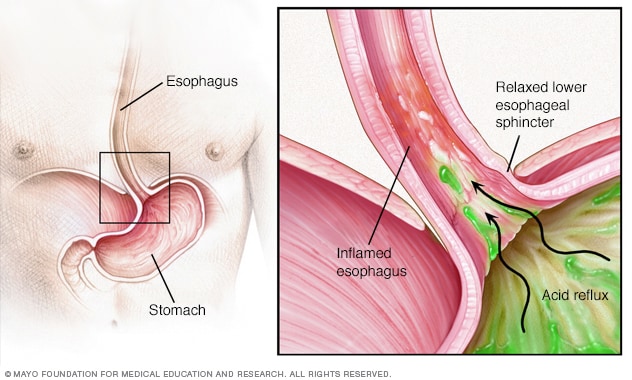

You may also be asked to swallow a barium pill that can help diagnose a narrowing of the esophagus that may interfere with swallowing. The coating allows your doctor to see a silhouette of your esophagus, stomach and upper intestine. X-rays are taken after you drink a chalky liquid that coats and fills the inside lining of your digestive tract. Esophageal manometry also measures the coordination and force exerted by the muscles of your esophagus. This test measures the rhythmic muscle contractions in your esophagus when you swallow. The monitor might be a thin, flexible tube (catheter) that's threaded through your nose into your esophagus, or a clip that's placed in your esophagus during an endoscopy and that gets passed into your stool after about two days. The monitor connects to a small computer that you wear around your waist or with a strap over your shoulder. A monitor is placed in your esophagus to identify when, and for how long, stomach acid regurgitates there. An endoscopy can also be used to collect a sample of tissue (biopsy) to be tested for complications such as Barrett's esophagus. Test results can often be normal when reflux is present, but an endoscopy may detect inflammation of the esophagus (esophagitis) or other complications. Your doctor inserts a thin, flexible tube equipped with a light and camera (endoscope) down your throat, to examine the inside of your esophagus and stomach. Which drugs are risk factors for the development of gastroesophageal reflux disease? turkjgastroenterol. nhs.uk/conditions/heartburn-and-acid-reflux/ Are rice and spicy diet good for functional gastrointestinal disorders? /pubmed/20535343 health-information/digestive-diseases/acid-reflux-ger-gerd-adults/eating-diet-nutrition Eating, diet, & nutrition for GER and GERD.Foods inducing typical gastroesophageal reflux disease symptoms in Korea. You can learn more about how we ensure our content is accurate and current by reading our editorial policy. Healthline has strict sourcing guidelines and relies on peer-reviewed studies, academic research institutions, and medical associations. Last medically reviewed on September 7, 2021 They may be able to recommend alternative medications or strategies to help manage your symptoms. You might also notice symptoms after taking medications or supplements.

Try to avoid high fat foods, spicy foods, and certain fruits, vegetables, and beverages if they trigger symptoms. In addition, magnesium or aluminum buildup can potentially be a concern for those with kidney disease.Įating smaller portions and trying to stay in an upright position after meals may help. Long-term effects of antacid use may include Īntacid overuse may also cause hypercalcemia, or too much calcium in your blood, which can affect many organ systems. They quickly neutralize stomach acids for the prevention of pain associated with acid reflux, but they will not heal or treat the inflamed esophagus. Antacids are intended as a short-term solution to a long-term concern. It’s important to note that long-term use of antacids may result in unwanted health effects. Making adjustments to your diet and eating habits can help you reduce your acid reflux symptoms and your need for antacids.
+or+chronic+acid+reflux-640w.jpg)
There’s still some controversy in the medical community over which foods actually cause reflux symptoms.ĭespite this lack of consensus, many researchers agree that it’s best to avoid certain types of foods and beverages to prevent indigestion and other symptoms of acid reflux. Knowing which foods to avoid can be a bit more confusing. Simply shifting your body position to an upright posture after a meal and eating smaller portions may help prevent reflux. You can manage each of these factors by modifying how and what you eat.

the amount of food you eat during a single meal.Several food-related factors may contribute to acid reflux, such as: Your doctor may diagnose your acid reflux as gastroesophageal disease (GERD) if this happens more than twice per week. This occurs when your lower esophageal sphincter (LES) relaxes and allows stomach acid to rise. Acid reflux happens when the contents of your stomach back up into your esophagus.


 0 kommentar(er)
0 kommentar(er)
